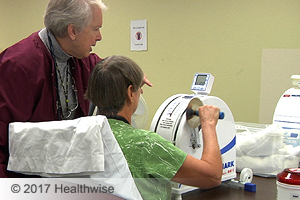Cardiac Rehabilitation: Monitoring Your Body's Response to Exercise
Overview

There are several ways to measure your body's responses to exercise and other lifestyle changes. You may want to keep track of the following measurements during your exercise sessions at cardiac rehab and at home.
Target heart rate
Your target heart rate can guide you to how hard you need to exercise so you can get the most aerobic benefit from your workout.
At the beginning of your rehab, the staff may give you a target heart rate goal to start with. You can use your target heart rate to know how hard you need to exercise to gain the most aerobic benefit from your workout. You will probably exercise at the lower end of your target heart rate. As you progress through the phases of cardiac rehab and you stay more active, you may exercise harder (at the upper end of your target heart rate range).
Rating of perceived exertion
Rating of perceived exertion (RPE) is a valuable and reliable indicator in monitoring your exercise tolerance. It is usually used as part of an organized cardiac rehab program. It is probably most useful to first learn about RPE with a health professional, such as an exercise physiologist or trainer. And then you may be able to use it when you exercise on your own. During exercise, you will want to monitor for and report any angina symptoms, such as chest pain or pressure, to your doctor.
The RPE is a means of determining how hard you are exerting yourself, including physiological (how hard you are breathing, how fast your heart is beating) and muscular strain (how much you feel the exertion in your muscles).
Blood pressure
If you are in a supervised cardiac rehab program, your blood pressure (BP) will also be monitored in addition to HR and RPE. You may want to be aware of your BP during exercise that you do by yourself. You should expect a gradual increase in your systolic BP (the first number), while your diastolic BP (the second number) should show very little change. If this does not happen, consider any medicines you may be taking that could affect your BP and/or call your doctor.
Angina
Angina symptoms are caused by your heart muscle not getting enough blood flow (myocardial ischemia). Your angina may feel like chest pain or discomfort. But you might feel it in other parts of your body. In any case, note if increased effort leads to any symptoms that can be relieved by rest or nitroglycerin.
For some people with heart problems, angina always occurs during activity. And these people must monitor the severity of the pain or stop doing the activity. Other people with heart problems rarely or never have angina. Either way, it is important that you recognize angina and know what is usual for you.
Unless your doctor has specifically told you differently, you should stop exercising when you feel angina symptoms. Talk to your doctor about when you should call about angina symptoms. There are also medicines your doctor can suggest that you may be able to carry with you to treat your angina.
Shortness of breath
If you have difficulty breathing during exercise, your heart may be having trouble keeping up with the intensity of your exercise. This difficulty breathing or shortness of breath is called dyspnea. The dyspnea rating scale will help you identify how difficult your breathing has become.
Your level of dyspnea during exercise will vary depending upon your cardiac history and current health status. Your health professionals' recommendations for an acceptable level of dyspnea will also vary.
|
Rating number |
Amount of dyspnea |
|---|---|
|
0 |
No dyspnea |
|
1 |
Mild, noticeable |
|
2 |
Mild, some difficulty |
|
3 |
Moderate difficulty, but can continue |
|
4 |
Severe difficulty, cannot continue |
By monitoring your level of dyspnea, you can find out the level of exercise intensity that is most appropriate for you. Usually, you want to keep your dyspnea level during exercise lower than a level 3. Report to your doctor if and when you experience any abnormal shortness of breath.
Recording measurements
An exercise diary is an excellent way to keep track of your current aerobic level as well as identify improvement. With each note you should record the time, distance, and mode of activity. Include any additional information such as weather conditions, clothing, specific terrain, time of day, and overall feeling.
|
Date |
Activity |
Time |
Comments |
|---|---|---|---|
|
3/15/2010 |
Walking |
25 minutes |
Went approximately 1.5 miles. Weather was a little windy so I wore a sweater. Stayed on the footpath. Overall it felt good with no pain. I did 10 minutes of stretching when I got home. |
Related Information
Credits
Current as of: October 2, 2025
Author: Ignite Healthwise, LLC Staff
Clinical Review Board
All Ignite Healthwise, LLC education is reviewed by a team that includes physicians, nurses, advanced practitioners, registered dieticians, and other healthcare professionals.
Current as of: October 2, 2025
Author: Ignite Healthwise, LLC Staff
Clinical Review Board
All Ignite Healthwise, LLC education is reviewed by a team that includes physicians, nurses, advanced practitioners, registered dieticians, and other healthcare professionals.



